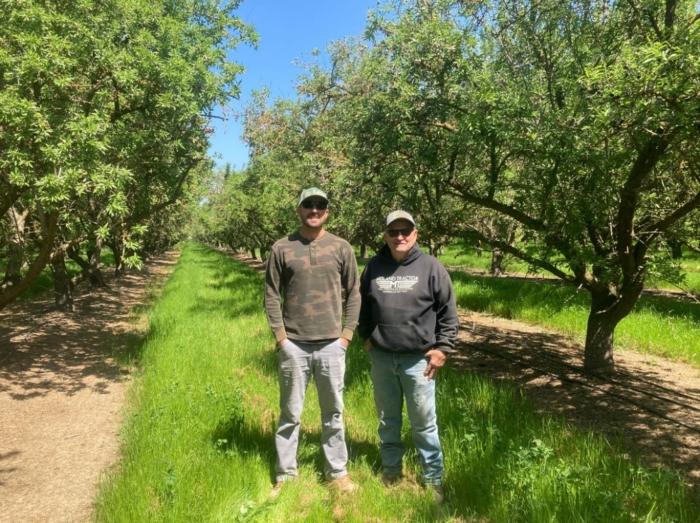T Double R Farms

Introduction
Ten years ago, Rob Schuh was on the verge of retiring as a farmer. Being a lifelong farmer, he had become disillusioned by how farming had become a series of numbers, adding and subtracting pounds of fertilizer, herbicide, and pesticide every year. Then he discovered ideas on regenerative farming, alongside his son-in-law Andrew. Regenerative farming, gave Rob Schuh a new found appreciation for agriculture and the land.
The more he learned, the more it made sense with his decades of experience: treating his 210 acres of almond orchards in Merced, CA as a living, complex ecosystem. The holistic approach that Rob Schuh began to develop on his orchard led him to add Climate Smart Agriculture practices that would in turn benefit his soils. The two Climate Smart Agriculture practices that he decided to implement were cover cropping and compost application. With the help of Community Educators, he began incorporating compost and cover cropping, while reducing many of his inputs such as synthetic fertilizer and chemical pesticides. While he has become reengaged with his land and excited about farming again, this shift has also had significant benefits on the bottom line.
Soil Health, Economic, Water Quality, and Climate Benefits
Cover Crop Management
Schuh plants a diverse cover crop mix (this year it included 16 species) in his orchard rows every fall with a rented seed drill. When surface water is available, he floods his orchards once a month. If not, the winter rains still provide enough water to produce a healthy cover crop stand. He tries to keep his cover crops growing as long as possible throughout the spring and early summer, mowing every few weeks with his flail mower and finally using his stick jack to clear the rows of residue before harvest.
Chemical Costs
Schuh saves an average of $38,000 per year on farm inputs since beginning cover cropping and applying compost. He has reduced his synthetic nitrogen application from around 300 units/acre of UN32 to about 75 per year, and plans to continue reducing. He applies almost no herbicides and pesticides now, and doesn’t need to treat for navel orangeworm. He started applying nutrients through aerial sprays to achieve better precision to his tree canopies.
Irrigation
Schuh has a mix of microsprinklers and double-line drip, and also floods once a month when water is available.
“Cover crops needing extra water is a myth”
– Rob Schuh
Since beginning to cover crop, he has noticed better water retention and infiltration in his soil. He has reduced his irrigation sets from 48 hours to 36 hours. Even in years where no surface water is available, he still gets decent cover crop stands in the middle of his rows from just rainwater.
Labor Costs
While difficult to quantify the labor costs on his farm, as most of it is done by himself and his son-in-law, Rob estimates that labor has stayed about the same since implementing these practices. They of course spend more time planting the cover crops, mowing them, and applying compost. However, they significantly reduced their pesticide applications and no longer need to pay for orchard sanitation and mummy shakes.
Yields
There has been no statistically significant impact on yields since he began cover cropping 6 years ago. There is a statistical insignificant slight downward trend in yield, but his trees were 17/18 years old when he began cover cropping so this is most likely due to his trees being past peak yield.
Equipment Costs
Rob already owned a flail mower, and added a stickjack to it for a one-time cost of $11,000. He rents a seed drill every fall to plant his cover crops, which costs about $2,500.
Closing Thoughts
Incorporating these practices into Schuh’s orchard allowed him to reconnect to his passion for farming and agriculture. Schuh and Andrew are avid learners about regenerative practices and the effect these practices have on the land.
Economic Effects of Cover Crops on T Double R Farms
| Item ($/year) | Before | After | Net Savings |
|
Fertilizer/Pesticide/Herbicide |
$ 257,250 |
$ 136,080 |
$ 121,170 |
|
Aerial Applications |
$ - |
$ 23,200 |
$ (23,200) |
|
Seed and Planter Rental |
$ - |
$ 8,904 |
$ (8,904) |
|
Compost |
$ - |
$ 50,093 |
$ (50,093) |
|
$ 38,973 Yearly Benefit |
|||
Thank you to T Double R Farms and Jesse Voremberg for your contributions!
For any questions regarding this soil health case study please contact us at:climatesmartcesteam@groups.ucdavis.edu
